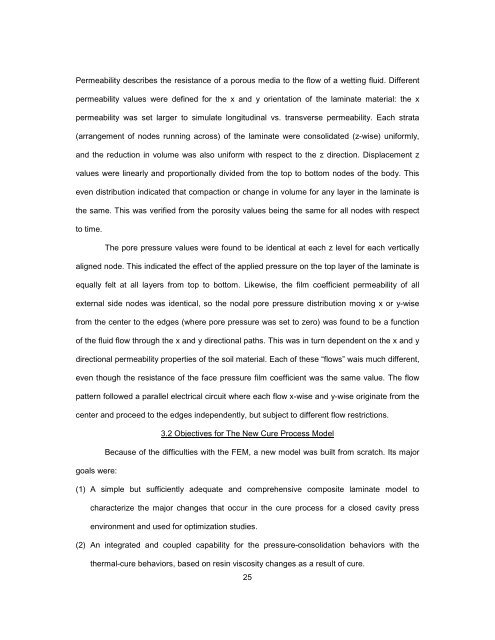TOOLED THICK COMPOSITES by ARVEN H. SAUNDERS III ...
TOOLED THICK COMPOSITES by ARVEN H. SAUNDERS III ...
TOOLED THICK COMPOSITES by ARVEN H. SAUNDERS III ...
You also want an ePaper? Increase the reach of your titles
YUMPU automatically turns print PDFs into web optimized ePapers that Google loves.
Permeability describes the resistance of a porous media to the flow of a wetting fluid. Different<br />
permeability values were defined for the x and y orientation of the laminate material: the x<br />
permeability was set larger to simulate longitudinal vs. transverse permeability. Each strata<br />
(arrangement of nodes running across) of the laminate were consolidated (z-wise) uniformly,<br />
and the reduction in volume was also uniform with respect to the z direction. Displacement z<br />
values were linearly and proportionally divided from the top to bottom nodes of the body. This<br />
even distribution indicated that compaction or change in volume for any layer in the laminate is<br />
the same. This was verified from the porosity values being the same for all nodes with respect<br />
to time.<br />
The pore pressure values were found to be identical at each z level for each vertically<br />
aligned node. This indicated the effect of the applied pressure on the top layer of the laminate is<br />
equally felt at all layers from top to bottom. Likewise, the film coefficient permeability of all<br />
external side nodes was identical, so the nodal pore pressure distribution moving x or y-wise<br />
from the center to the edges (where pore pressure was set to zero) was found to be a function<br />
of the fluid flow through the x and y directional paths. This was in turn dependent on the x and y<br />
directional permeability properties of the soil material. Each of these “flows” wais much different,<br />
even though the resistance of the face pressure film coefficient was the same value. The flow<br />
pattern followed a parallel electrical circuit where each flow x-wise and y-wise originate from the<br />
center and proceed to the edges independently, but subject to different flow restrictions.<br />
goals were:<br />
3.2 Objectives for The New Cure Process Model<br />
Because of the difficulties with the FEM, a new model was built from scratch. Its major<br />
(1) A simple but sufficiently adequate and comprehensive composite laminate model to<br />
characterize the major changes that occur in the cure process for a closed cavity press<br />
environment and used for optimization studies.<br />
(2) An integrated and coupled capability for the pressure-consolidation behaviors with the<br />
thermal-cure behaviors, based on resin viscosity changes as a result of cure.<br />
25
















